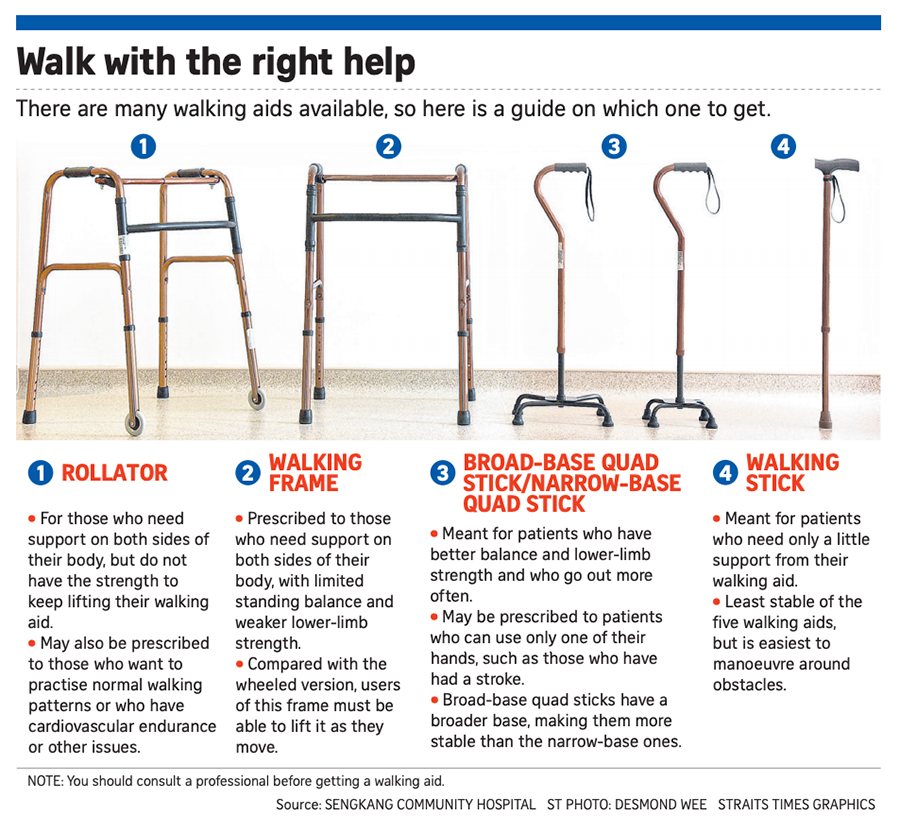The Straits Times (13 January 2020)

The height of a walking aid should be adjusted to the user’s wrist level, so that when it is grasped,
there is a slight bend in the user’s elbow. PHOTO: ISTOCKPHOTO
When Chinese New Year comes around, some of the less mobile elderly, who may not ordinarily leave their homes, will be stepping out to visit family and friends.
Some who typically rely on walking aids to get around may be tempted to switch to an umbrella instead for support. But this would be a mistake, says physiotherapist Chitra Chandran.
“Some elderly use umbrellas (as walking aids) because they think a walking aid doesn’t look nice,” said Ms Chitra, a senior physiotherapist with Sengkang Community Hospital.
“But the trouble is umbrellas have no fixed weight limit, so with use, they may get bent. There’s also a risk of them breaking, resulting in a fall.” In addition, not all umbrellas come with ferrules – the rubber stoppers at the base of walking aids which help provide grip. Umbrellas also do not have an adjustable height, which may result in shoulder or back pain, said Ms Chitra.
She added that aside from umbrellas, some people also use hiking sticks as walking aids. But this comes with its own set of issues too.
“The purpose of the hiking stick is not for support when walking over regular ground... If you’re an older person who really needs a walking aid, a hiking stick may not give you sufficient support. You have to use an item appropriately,” she said.
“Using makeshift items as walking aids can increase your risk of a fall, so we don’t recommend that.” Those who need walking aids should get ones recommended by a healthcare professional, said Ms Chitra, who also advises getting a consultation to assess the most suitable aid instead of buying one off the shelf.
Assessing which type to get or whether an aid is needed in the first place is not a straightforward process, she added.
“There are quite a few factors therapists usually consider before we prescribe a walking aid.
“For instance, a family member may come to us thinking, ‘My mum needs a walking frame because her legs are weak.’
But a therapist may assess her and find that it’s unsafe because the patient cannot remember the correct steps to use a walking aid appropriately and may end up tripping and falling.”

Ms Natalie Yee, a senior physiotherapist at Tan Tock Seng Hospital’s Department of Physiotherapy, shared similar sentiments.
“A walking aid that is not appropriate for an individual’s specific needs – for instance, using a walking aid at an incorrect height or using a walking stick instead of walking frame – may increase his risk of falls,” she said.
This is more common when one uses a walking aid purchased off the shelf rather than one prescribed by a professional, she added. There are five types of walking aids: walking frames; rollators, which are walking frames with wheels; broad-base quad sticks; narrow-base quad sticks; and walking sticks. Each type helps with different mobility issues.
For instance, rollators are intended for those who need support on both sides of their body, but do not have the strength to keep lifting their walking aid.
Such frames may also be prescribed to those who want to practise normal walking patterns or who have reduced cardiovascular endurance or other issues.
Walking frames, on the other hand, are prescribed to those with limited standing balance and weaker lower-limb strength.
According to Britain’s Disabled Living Foundation, a walking frame can redistribute over 60 per cent of a user’s weight from his legs to his arms, while a walking stick takes about 25 per cent of the weight off the legs.
Single-sided walking aids such as quad sticks and walking sticks are meant for those with better balance and lower-limb strength, and who go out more often. Broad-base quad sticks are more stable than narrow-base ones, while walking sticks are meant for patients who need only a little bit of support, said Ms Chitra.
But while some may want to “play it safe” and go for the more stable options regardless of their condition, this is not recommended as the size of the base of these aids may make it difficult to navigate obstacles.
“It can pose a risk if (broad-base quad sticks) are improperly placed on a kerb or while crossing a road,” said Ms Chitra.
She added that the height of a walking aid should be adjusted to the user’s wrist level, so that when it is grasped, there is a 20- to 30- degree bend in his or her elbow.
“If it’s too high, it will hike up your shoulder and you will end up with shoulder pain.
And if it’s too low, you’ll end up bending your body, leading to back pain,” said Ms Chitra.
There is a proper technique to walking with an aid as well.
Single-sided walking aids should be held on the same side of the body as the user’s strong leg to give him or her a wider base of support.
For all walking aids, the user should first move it forward, then his or her weak leg, followed by the strong leg.
This will allow the walking aid to support the user’s weak leg as he or she brings it forward, said Ms Chitra.
The same sequence goes for climbing down stairs, as the user’s stronger leg is needed to support his or her body weight. When climbing up stairs, however, the user should move the walking aid first, followed by his or her strong leg and then the weak leg.
This will give the user the strength to propel his or her body upwards, and up the stairs, said Ms Chitra.
She said that around 70 per cent of elderly rehabilitation patients at the three SingHealth Community Hospitals – Bright Vision Hospital, Sengkang Community Hospital and Outram Community Hospital – may require a walking aid.
“If you start noticing a loved one is walking unsteadily, or hear that he or she had a near fall... these are red flags and you might want to consider taking him or her to a doctor to see if he or she needs a walking aid,” she said.
A walking aid becomes a liability if it is worn out from prolonged use, putting the user at higher risk of falls.
Look out for rusting of the metal body, worn-out ferrules or a broken handle, said Ms Yee.
She also cautioned that not everyone should use a walking aid either.
“Individuals who are able to move around independently and steadily, or who have difficulty learning how to use walking aids appropriately, should avoid using them unless prescribed by a healthcare professional.” Ms Chitra said, depending on their personality and condition, some patients can be weaned off their walking frames and progress to using a walking stick.
“But if they are very fearful of just letting go, and they always feel they’re about to fall, they may end up depending heavily on the walking aid.”
On the flipside, she has observed some users who have picked up the correct use of a walking aid and can move independently, but are restricted by family members from moving around too much.
This is not ideal, she says, “because the less you mobilise yourself, the weaker your legs become, and it increases your risk of falls”.
“If you don’t use it, you lose it.”